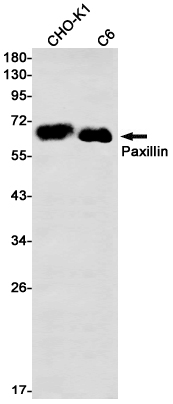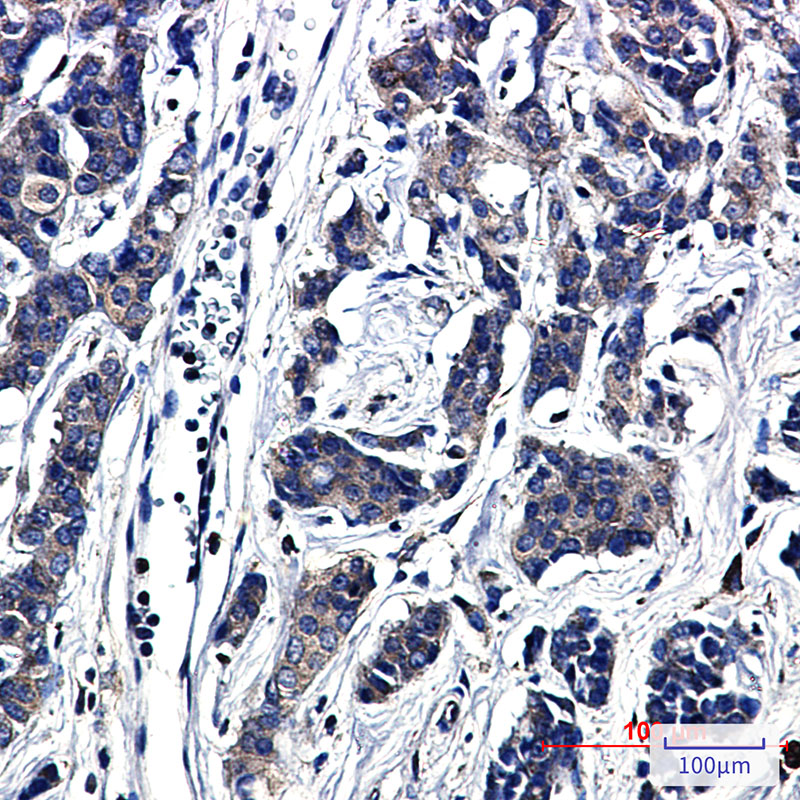


| WB | 1/500-1/1000 | Human,Rat,Hamster |
| IF | 1/20 | Human,Rat,Hamster |
| IHC | 1/50-1/100 | Human,Rat,Hamster |
| ICC | 技术咨询 | Human,Rat,Hamster |
| FCM | 咨询技术 | Human,Rat,Hamster |
| Elisa | 咨询技术 | Human,Rat,Hamster |
| Aliases | PXN; Paxillin |
| Entrez GeneID | 5829 |
| WB Predicted band size | Calculated MW: 65 kDa; Observed MW: 65 kDa |
| Host/Isotype | Rabbit IgG |
| Antibody Type | Primary antibody |
| Storage | Store at 4°C short term. Aliquot and store at -20°C long term. Avoid freeze/thaw cycles. |
| Species Reactivity | Human,Rat,Hamster |
| Immunogen | A synthetic peptide of human Paxillin |
| Formulation | Purified antibody in TBS with 0.05% sodium azide,0.05%BSA and 50% glycerol. |
+ +
以下是关于Paxillin抗体的3篇代表性文献的简要信息:
---
1. **文献名称**:*"Paxillin: a new vinculin-binding protein localized in focal adhesions"*
**作者**:Schaller, M.D. et al. (1995)
**摘要**:该研究首次报道了Paxillin作为黏着斑关键蛋白的特性,并描述了其抗体的开发与应用。通过免疫沉淀和免疫荧光技术,验证了Paxillin在细胞黏附及信号转导中的作用,为后续研究提供了重要工具。
2. **文献名称**:*"Tyr phosphorylation of paxillin via the Rac1-JNK pathway: regulation by cell adhesion and cytoskeletal tension"*
**作者**:Brown, M.C. & Turner, C.E. (2005)
**摘要**:研究利用特异性抗磷酸化酪氨酸抗体(如抗pY31/pY118 Paxillin),揭示了Paxillin磷酸化在细胞迁移中的调控机制,强调了抗体在检测力学信号依赖的磷酸化修饰中的关键作用。
3. **文献名称**:*"Paxillin regulates cell polarization and tissue repair through microtubule-based Rac1 activation"*
**作者**:Nakamura, K. et al. (2018)
**摘要**:通过多种Paxillin抗体(如克隆号H-114)进行免疫印迹和共聚焦成像,阐明了Paxillin通过微管骨架调控Rac1激活的分子机制,为理解其在组织修复中的应用提供了依据。
---
这些文献涵盖了Paxillin抗体的开发、磷酸化特异性检测及功能研究,适用于Western blot、免疫荧光和信号通路分析等场景。如需具体实验细节或更多文献,可进一步检索PubMed或CiteAb数据库。
Paxillin is a multifunctional adaptor protein primarily localized at focal adhesions, dynamic structures that mediate cell-extracellular matrix (ECM) interactions. It plays a critical role in regulating cell adhesion, migration, and signaling by acting as a scaffold for recruiting signaling molecules, including kinases (e.g., FAK, Src) and structural proteins. Structurally, paxillin contains LD motifs and LIM domains that facilitate protein-protein interactions, enabling its involvement in integrin-mediated signaling pathways. Its phosphorylation at specific tyrosine (Y31. Y118) or serine residues modulates cellular responses to mechanical and chemical cues, influencing cytoskeletal reorganization and cell motility.
Paxillin antibodies are essential tools for studying these processes in cancer, developmental biology, and tissue repair. They are widely used in techniques like Western blotting, immunofluorescence, and immunoprecipitation to detect paxillin expression, post-translational modifications, and subcellular localization. In cancer research, these antibodies help investigate metastasis, as paxillin overexpression or hyperphosphorylation correlates with invasive tumor behavior. Similarly, they aid in exploring cardiovascular diseases and fibrosis, where aberrant focal adhesion signaling contributes to pathology. Commercially available paxillin antibodies often target conserved regions (e.g., N-terminus) or specific phosphorylation sites, with validation across species (human, mouse, rat). Proper controls (e.g., knockout cells) are critical to ensure specificity, given paxillin’s homology with related proteins like Hic-5.
×